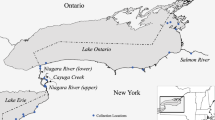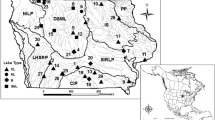Abstract
The risk of mercury (Hg) exposure to humans and wildlife from fish consumption has driven extensive mercury analysis throughout the Great Lakes Region since the 1970s. This study compiled fish-Hg data from multiple sources in the region and assessed spatiotemporal trends of Hg concentrations in two representative top predator fish species. Walleye (Sander vitreus) and largemouth bass (Micropterus salmoides) were chosen for the trend analysis because they had more Hg records (63,872) than other fish species that had been sampled from waters throughout the region. Waterbody types were inland lakes (70%), the Great Lakes, impoundments, and rivers. The compiled datasets were analyzed with a mixed effects statistical model having random effects of station, year, and fish length; and fixed effects of year, tissue type, fish length, habitat, and season. The results showed a generally declining temporal trend in fish-Hg for the region (1970–2009), with spatial trends of increasing Hg concentration from south to north and from west to east across the region. Nonlinearity was evident in the general downward trends of Ontario walleye, with a shift to an upward trend beginning in the 1990s. Only ongoing monitoring can reveal if this upward shift is an oscillation in a long-term decline, a statistical anomaly, or a sustained declining temporal trend in regional fish-Hg concentrations.







Similar content being viewed by others
References
Anderson HA, Amrhein JF, Shubat P, Hesse J (1993) Protocol for a uniform Great Lakes Sport Fish consumption advisory. Chicago, IL: Great Lakes Sport Fish Advisory Task Force, Council of Great Lakes Governors
Austin J, Colman S (2008) A century of temperature variability in Lake Superior. Limnol Oceanogr 53:2724–2730
Bhavsar SP, Awad E, Mahon CG, Petro S (This issue) Great Lakes fish consumption advisories: is mercury a concern? Ecotoxicology. doi:10.1007/s10646-011-0731-0
Bhavsar SP, Gewurtz SB, McGoldrick DJ, Keir MJ, Backus SM (2010) Changes in mercury levels in Great Lakes fish between 1970s and 2007. Environ Sci Technol 44:3273–3279
Boudreau SA, Yan ND (2003) The differing planktonic crustacean zooplankton communities of Canadian Shield lakes with and without the nonindigenous zooplanktivore Bythotrephes longiamanus. Can J Fish Aquat Sci 60:1307–1313
Butler TJ, Cohen MD, Vermeylen FM, Likens GE, Schmeltz D, Artz RS (2008) Regional precipitation mercury trends in the eastern USA, 1998–2005: declines in the northeast and mid-west, no trend in the southeast. Atmos Environ 42:1582–1592
Carrie J, Wang F, Sanei H, Macdonald RW, Outridge PM, Stern GA (2010) Increasing contaminant burdens in an arctic fish, burbot (Lota lota), in a warming climate. Environ Sci Technol 44:316–322
Chalmers AT, Argue DM, Gay DA, Brigham ME, Schmitt CJ, Lorenz DL (2010) Mercury trends in fish from rivers and lakes in the United States, 1969–2005. Environ Monit Assess Online: 10 June 2010
Chen CY, Folt CL (2005) High plankton densities reduce mercury biomagnification. Environ Sci Technol 39:115–121
Dittman JA, Driscoll CT (2009) Factors influencing changes in mercury concentrations in lake water and yellow perch (Perca flavescens) in Adirondack Lakes. Biogeochemistry 93:179–196
Gewurtz SB, Bhavsar SP, Jackson DA, Fletcher R, Awad E, Moody R, Reiner EJ (2010) Temporal and spatial trends of organochlorines and mercury in fishes from the St. Clair River/Lake St. Clair corridor, Canada. J Gt Lakes Res 36:100–112
Gewurtz SB, Bhavsar SP, Fletcher R (2011) Influence of fish size and sex on mercury/PCB concentration: Importance of fish consumption advisories. Environ Int 37:425–434
Green DM, Heidinger RC (1994) Longevity record for largemouth bass. N Am J Fish Manag 14:464–465
Greenfield BK, Hrabik TR, Harvey CJ, Carpenter SR (2001) Predicting mercury levels in yellow perch: use of water chemistry, trophic ecology, and spatial traits. Can J Fish Aquat Sci 58:1419–1429
Harris RC, Bodaly RA (1998) Temperature, growth and dietary effects on fish mercury dynamics in two Ontario lakes. Biogeochemistry 40:175–187
Hartman KJ, Margraf FJ (2006) Relationships among condition indices, feeding and growth of walleye in Lake Erie. Fish Manage Ecol 13:121–130
Hebert PDN, Muncaster BW, Mackie GL (1989) Ecological and genetic studies on Dreissena polymorpha (Pallas): a new mollusc in the Great Lakes. Can J Fish Aquat Sci 46:1587–1591
Helser TE, Lai H-L (2004) A Bayesian hierarchical meta-analysis of fish growth: with an example for North American largemouth bass, Micropterus salmoides. Ecol Model 178:399–416
Henderson BA, Collins N, Morgan GE, Vaillancourt A (2003) Sexual size dimorphism of walleye (Stizostedion vitreum vitreum). Can J Fish Aquat Sci 60:1345–1352
Hogan LS, Marschall E, Folt C, Stein RA (2007) How non-native species in Lake Erie influence trophic transfer of mercury and lead to top predators. J Great Lakes Res 33:46–61
Jackson ZJ, Quist MC, Larscheid JG (2008) Growth standards for nine North American fish species. Fish Manage Ecol 15:107–118
Jobling MA (1981) Temperature tolerance and the final preferendum—rapid methods for the assessment of optimum growth temperatures. J Fish Biol 19:439–455
Jude DJ, Reider RH, Smith GR (1992) Establishment of Gobiidae in the Great Lakes basin. Can J Fish Aquat Sci 49:416–421
Kamman NC, Burgess NM, Driscoll CT, Simonin HA, Goodale W, Linehan J, Estabrook R, Hutcheson M, Major A, Scheuhammer AM, Scruton DA (2005) Mercury in freshwater fish of northeast North America—a geographic perspective based on fish tissue monitoring databases. Ecotoxicology 14:163–180
Kirk JL, Muir DCM, Antoniades D, Douglas MSV, Evans MS, Jackson TA, Kling H, Lamoureux S, Lim DSS, Pienitz R, Smol JP, Stewart K, Wang X, Yang F (2011) Climate change and mercury accumulation in Canadian high and subarctic lakes. Environ Sci Technol 45:964–970
Kutner MH, Nachtsheim CJ, Neter J, Li W (2005) Applied linear statistical models, 5th edn. McGraw, New York
Lavigne M, Lucotte M, Paquet S (2010) Relationship between mercury concentration and growth rates for walleyes, northern pike, and lake trout from Quebec lakes. N Am J Fish Manag 30:1221–1237
Levinton JS, Pochron ST (2008) Temporal and geographic trends in mercury concentrations in muscle tissue in five species of Hudson River, USA, Fish. Environ Toxicol Chem 27:1691–1697
Madsen ER, Stern HS (2007) Time trends of methylmercury in walleye in northern Wisconsin: a hierarchical Bayesian analysis. Environ Sci Technol 41:4568–4573
Monson BA (2009) Trend reversal of mercury concentrations in piscivorous fish from Minnesota lakes: 1982–2006. Environ Sci Technol 43:1750–1755
Munthe J, Bodaly RA, Branfireun BA, Driscoll CT, Gilmour CC, Harris R, Horvat M, Lucotte M, Malm O (2007a) Recovery of mercury-contaminated fisheries. Ambio 36:33–44
Munthe J, Wangberg I, Rognerud S, Fjeld E, Verta M, Porvari P, Meili M (2007b) Mercury in Nordic ecosystems. IVL Swedish Environmental Research Institute, Göteborg, Sweden
Pacyna EG, Pacyna JM, Steenhuisen F, Wilson S (2006) Global anthropogenic mercury emission inventory for 2000. Atmos Environ 40:4048–4063
Prestbo EM, Gay DA (2009) Wet deposition of mercury in the US and Canada, 1996–2005: results and analysis of the NADP mercury deposition network (MDN). Atmos Environ 43:4223–4233
Quist MC, Guy CS, Schultz RD, Stephen JL (2003) Latitudinal comparisons of walleye growth in North America and factors influencing growth of walleyes in Kansas reservoirs. N Am J Fish Manag 23:677–692
Rasmussen PW, Schrank CS, Campfield PA (2007) Temporal trends of mercury concentrations in Wisconsin walleye (Sander vitreus), 1982–2005. Ecotoxicology 16:541–550
Riget F, Vorkamp K, Muir D (2010) Temporal trends of contaminants in Arctic char (Salvelinus alpinus) from a small lake, southwest Greenland during a warming climate. J Environ Monit 12:2252–2258
Schneider JC, Eschmeyer PH, Crowe WR (1977) Longevity, survival and harvest of tagged walleyes in Lake Gogebic, Michigan. Trans Am Fish Soc 106:566–568
Simoneau M, Lucotte M, Garceau S, Laliberte D (2005) Fish growth rates modulate mercury concentrations in walleye (Sander vitreus) from eastern Canadian lakes. Environ Res 98:73–82
Simonin HA, Loukmas JJ, Skinner LC, Roy KM, Paul EA (2009) Trends in mercury concentrations in New York State fish. Bull Environ Contam Toxicol 83:214–218
Streets DG, Zhang Q, Wu Y (2009) Projections of global mercury emissions in 2050. Environ Sci Technol 43:2983–2988
Suns K, Hitchin G (1990) Interrelationships between Hg levels in yearling yellow perch and water quality. Water Air Soil Pollut 50:255–265
R Development Core Team (2010) R: A language and environment for statistical computing. Vienna, Austria: R Foundation for Statistical Computing
Wiener JG, Bodaly RA, Brown SS, Lucotte M, Newman DB, Porcella DB, Reash RJ, Swain EB (2007) Monitoring and evaluating trends in methylmercury accumulation in aquatic biota. In: Harris R, Krabbenhoft DP, Mason R, Murray MW, Reash RJ, Saltman T (eds) Ecosystem responses to mercury contamination: indicators of change. SETAC Books, CRC Press, Boca Raton, pp 87–122
Wyn B, Kidd KA, Burgess NM, Curry RA, Munkittrick KR (2010) Increasing mercury in yellow perch at a hotspot in Atlantic Canada, Kejimkujik National Park. Environ Sci Technol 44:9176–9181
Acknowledgments
We thank the tribal, state, provincial, and federal agencies for sharing their fish monitoring data. This project was made possible by the energetic leadership of David Evers and James Wiener. We greatly appreciate their efforts to conceive of and organize the Great Lakes Hg Project. We also appreciate the BioDiversity Research Institute’s compilation of MercNet and maintenance of the project web site. We thank the two anonymous reviewers for their thoughtful comments and suggestions to improve the draft manuscript. Funding for D. Staples and K. Williams was provided by a grant to BioDiversity Research Institute from the Great Lake Commission’s Great Lakes Atmospheric Deposition program.
Author information
Authors and Affiliations
Corresponding author
Electronic supplementary material
Below is the link to the electronic supplementary material.
Rights and permissions
About this article
Cite this article
Monson, B.A., Staples, D.F., Bhavsar, S.P. et al. Spatiotemporal trends of mercury in walleye and largemouth bass from the Laurentian Great Lakes Region. Ecotoxicology 20, 1555–1567 (2011). https://doi.org/10.1007/s10646-011-0715-0
Accepted:
Published:
Issue Date:
DOI: https://doi.org/10.1007/s10646-011-0715-0




